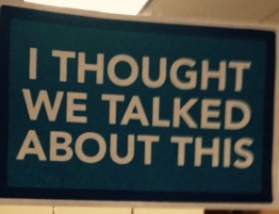
The Three Types of Functional Management
March 30, 2015
Seattle’s Community Festival Culture
April 7, 2015 CREATING THE “ALL-IN CULTURE”
There are four elements to creating an “All-In Culture”:
All stakeholders share a relentless “ALL-IN” to accomplish the organization’s mission and desired outcomes.
All organizational stakeholders are “ALL-IN” owning and adhering to the organizational process and protocols.
All organizational stakeholders are “ALL-IN” understanding the individual leadership and management behaviors that are the foundation for Collaborative/Innovative cultures.
All organizational stakeholders are “ALL-IN” trusting organizational “Decision Competency”.
ALL-IN CULTURE
This is an attempt to blend the needed elements of the traditional Command and Control culture that the Baby Boomers are attached to, with the elements of the growing trend of people defining their chosen Life Style, and prioritizing Life Style over being successful – as measured by the amount of money and toys you collect. When you look at the factors that define Command and Control culture, it is obvious that no one wins. The “All-In Culture” re-defines the system that everyone has to agree upon to get what the organization requires, in order to manage the constant change in our current business environment.
HOW DO WE GET THERE?
Getting to a new and embraced “All-In Culture” will take all of the skills required with any organizational change. Organizational leaders today are tasked with an almost impossible amount of required intelligences. Today’s Leadership needs to be proficient in understanding the “Meyers Briggs Profile” – knowing yourself and understanding others was the intelligence lesson of the 1980s and early 90s – then, along came “Emotional Intelligence”, which focused on street smarts vs. book smarts. Over the last 10 years you would have also needed to be competent in understanding the “Social Media” explosion. Then, it helps if you have “Ethnic Intelligence”, as well as “Religious Intelligence”, and “Immigration Intelligence” – and now, the biggest new understanding is “Generational Intelligence”.
The ability to have empathy for all of the above “Intelligences”, and the skill to manage culture change, concurrent with competency in driving your business model, seems like a large and daunting task. I contend that all these factors in the mix at the same time may make this “All-In Culture” shift easier than in previous times.
Complexity forces Simplicity.
HOW DID I GET INTERESTED IN BUILDING PRODUCTIVE CULTURES?
I became interested in the concept of culture and leadership while I was at the University of Washington; as a college basketball player, how do you get 12 young men to understand the coaches’ system and play their role in helping the team be successful?
I was blessed to get 2 extra years of University education, earning my MBA while acting as the graduate assistant basketball coach, I decided when it came time to write my thesis that I would focus on what then was called “Theory X vs. Theory Y”, or democratic vs. autocratic leadership, developed by Douglas McGregor in his 1960 book titled “The Human Side of Enterprise”.
Theory X was the thought that employees needed to be closely supervised under a comprehensive system of behavioral control.
Theory Y suggested that employees can learn to seek out and accept responsibility, and to exercise self control and self direction in accomplishing organizational objectives.
I contrasted the coaching styles of two great college coaches, Marv Harshman and Tex Winter, both hall of fame coaches. Coach Harshman was a coach that tailored his system to match his talent [Theory Y] – while Coach Winter only allowed the players to work within his system [Theory X].
WHICH DO YOU BELIEVE TO BE THE BE THE MOST PRODUCTIVE WAY TO WIN BASKETBALL GAMES?
I discovered that both styles could be very successful and that the real issue was getting the players to be “ALL-IN” with the coach’s system and to be accountable for playing their role within that system.
Over the last 40 years of being a manager of people I have found the same to be true for regular business and government employees. To be successful at accomplishing almost anything with a group of individuals, the most important thing that leadership can do is to make sure that everyone involved is “ALL-IN” on the four basic factors of an “ALL-IN” organizational culture.
“ALL-IN” to accomplish the organization’s mission and desired outcomes.
“ALL-IN” owning and adhering the organizational process and protocols.
“ALL-IN” understanding the individual leadership and management behaviors that are the foundation for a Collaborative/Innovative culture.
“ALL-IN” trusting organizational “Decision Competency”.
There is a second question that needs to be understood:
WHICH WOULD YOU RATHER HAVE?
A GREAT ORGANIZATIONAL CULTURE
OR
A GREAT ORGANIZATIONAL STRATEGY
The last time Human Resources [Personnel] departments played a major role in organizational business strategy was in the early 1980’s, when the country added “Customer Service” as a required business strategy element. The book “The Nordstrom Way” written by Robert Spector, was – and is still – one of the leading voices on the discussion of customer service in America.
Since the early 2000’s, businesses starting changing their focus to “Continuous Improvement”, which has been mainly about cutting expenses. The goal was to improve profitability by doing everything possible to lower costs. In most cases, this meant having less people doing more work at as low a wage as possible. As is always the case, this business strategy can only be sustained so long before a host of outside influences take over. People can only be pushed so far, and at some point this focus on What we do and How we do it Better creates a disconnect between the employees and their passion for doing their jobs.
This is also the first time in history where there are 3 different generations working in the economy. Baby Boomers –Gen X – and the Millennials. The Millennials need to work as they play –socially and collaboratively. Command and Control culture does now work with this group, and “loyalty” and “waiting your turn” are “total loser” concepts with Millennials.
Over the last couple of years, as the business climate has gotten better, a new dilemma has appeared. New opportunities and new products are now the new norm. You either innovate or you look at the distinct possibility that your business will fail.
This dilemma has accelerated the discussion about which organizational culture enables the most innovation –
The answer to this question:
Culture executes a Strategy—Strategy does not create a Culture.
Conclusion:
There is no secret sauce that someone can buy to create an “ALL-IN Organizational Culture” These cultures are built on having people “ALL-IN” on the basic human interactions that can be taught and learned by all levels of an organization. This Blog has over 100 articles that have specific teachable behaviors and skills that are the backbone of building this “ALL-IN Culture”.
If you create this culture, you will give yourself the best chance of thriving in today’s complicated world.





